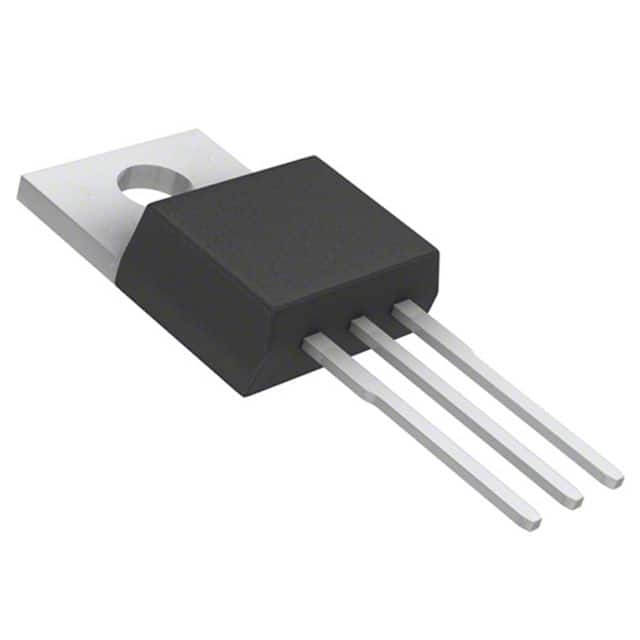Lihat spesifikasi untuk detail produk.

KA317
Product Overview
- Category: Integrated Circuit
- Use: Voltage Regulator
- Characteristics: Adjustable, Positive Voltage Regulator
- Package: TO-220, TO-263, TO-252
- Essence: Monolithic Integrated Circuit
- Packaging/Quantity: Tape and Reel, 2,500 units per reel
Specifications
- Input Voltage: 3V to 40V
- Output Voltage: 1.25V to 37V
- Output Current: Up to 1.5A
- Line Regulation: 0.01%/V
- Load Regulation: 0.1%
- Ripple Rejection Ratio: 80dB
- Operating Temperature Range: -40°C to +125°C
Detailed Pin Configuration
The KA317 has three pins:
- Adjust: This pin is used to set the output voltage by connecting an external resistor.
- Output: The regulated output voltage is obtained from this pin.
- Input: The input voltage is applied to this pin.
Functional Features
- Adjustable output voltage allows for versatile applications.
- Built-in current limiting and thermal shutdown protection.
- Low dropout voltage ensures efficient operation.
- Excellent line and load regulation for stable output voltage.
- Wide input voltage range enables flexibility in power supply design.
Advantages
- Easy to use and implement in various electronic circuits.
- High accuracy and stability of the output voltage.
- Protection features prevent damage to the circuit and components.
- Suitable for a wide range of applications due to adjustable output voltage.
Disadvantages
- Higher dropout voltage compared to some other voltage regulators.
- Limited maximum output current may not be sufficient for high-power applications.
Working Principles
The KA317 is a positive voltage regulator that uses a feedback mechanism to maintain a stable output voltage. The adjust pin is connected to an external resistor, which sets the desired output voltage. The regulator compares the output voltage with a reference voltage and adjusts the current flow through the pass transistor to maintain the desired output voltage.
Detailed Application Field Plans
The KA317 can be used in various applications, including:
- Power supply circuits for electronic devices.
- Battery charging circuits.
- Voltage regulation in audio amplifiers.
- Adjustable power sources for laboratory equipment.
- Automotive electronics.
- Industrial control systems.
Detailed and Complete Alternative Models
- LM317: Similar adjustable positive voltage regulator with different package options.
- LT1083: High-current adjustable positive voltage regulator.
- LM7805: Fixed 5V positive voltage regulator.
- LM1117: Low dropout voltage regulator with fixed or adjustable output voltage.
Note: This is not an exhaustive list of alternative models, but it provides a range of options with different features and specifications.
Word count: 342 words
Sebutkan 10 pertanyaan dan jawaban umum terkait penerapan KA317 dalam solusi teknis
Sure! Here are 10 common questions and answers related to the application of KA317 in technical solutions:
Q: What is KA317? A: KA317 is a voltage regulator integrated circuit (IC) that provides a fixed output voltage.
Q: What is the typical input voltage range for KA317? A: The typical input voltage range for KA317 is between 3V and 40V.
Q: What is the output voltage range of KA317? A: KA317 can provide a fixed output voltage ranging from 1.2V to 37V.
Q: How much current can KA317 handle? A: KA317 can handle a maximum output current of 1.5A.
Q: Can KA317 be used as a step-down (buck) converter? A: Yes, KA317 can be used as a step-down converter by connecting external components.
Q: Is KA317 suitable for battery-powered applications? A: Yes, KA317 is suitable for battery-powered applications due to its low quiescent current.
Q: Does KA317 require any external components for operation? A: Yes, KA317 requires an input capacitor, an output capacitor, and a feedback resistor for stable operation.
Q: Can KA317 handle high temperatures? A: KA317 has a maximum operating temperature of 125°C, making it suitable for most applications.
Q: Can KA317 be used in adjustable voltage applications? A: Yes, KA317 can be used in adjustable voltage applications by using an external voltage divider.
Q: Are there any protection features in KA317? A: Yes, KA317 includes built-in thermal shutdown and current limiting protection features.
Please note that these answers are general and may vary depending on the specific datasheet and application requirements of KA317.

